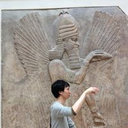Specific interaction between an oligosaccharide on the tumor cell surface and the novel antitumor agents, sulfoquinovosylacylglycerols.
Parole chiave
Astratto
Some sulfoquinovosylacylglycerols (SQAG) have been shown to be potent DNA polymerase inhibitors, and to have strong antitumor activity in vivo. In this study, we investigated the mode of action of SQAG with regard to the interaction with the tumor cell surface. Of the SQAG used, the monoacyl forms (SQMG) with C18-, C18:1- or C16-fatty acids (SQMG-alphaC18, -alphaC18:1 or -alphaC16) effectively inhibited cell proliferation of a human adenocarcinoma cell line, DLD-1, but SQMG-alphaC14 and the diacyl forms (SQDG) did not. Analysis of the interaction of SQMG-alphaC18 and -alphaC18:1 on three oligosaccharides of cell surface, sLe(A), Le(X), and SM3, by flow cytometry demonstrated that the most effective interaction was observed on sLe(A). DLD-1 cells bound to SQMG-alphaC18:1-coated plates, and this binding was inhibited by monoclonal antibody against sLe(A) or SM3. However, these cells did not bind to SQMG-alphaC14-coated plates. Moreover the cytotoxic effects of SQMG-alphaC18, -alphaC18:1 on DLD-1 cells was inhibited by monoclonal antibodies against sLe(A) or SM3. Our results suggested that the interaction of SQMGs and sLe(A) plays an important role in suppression of the DLD-1 cell proliferation.


